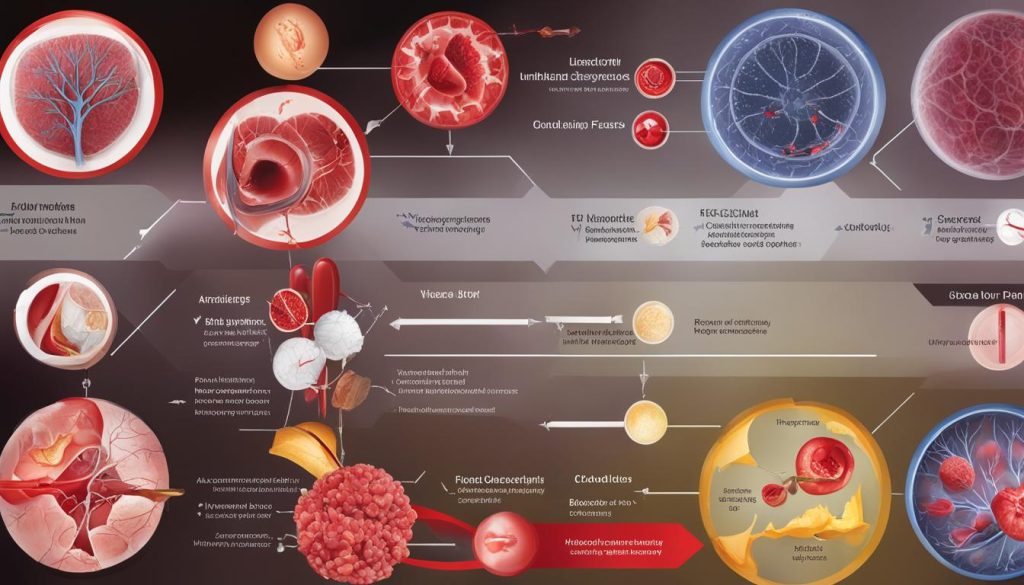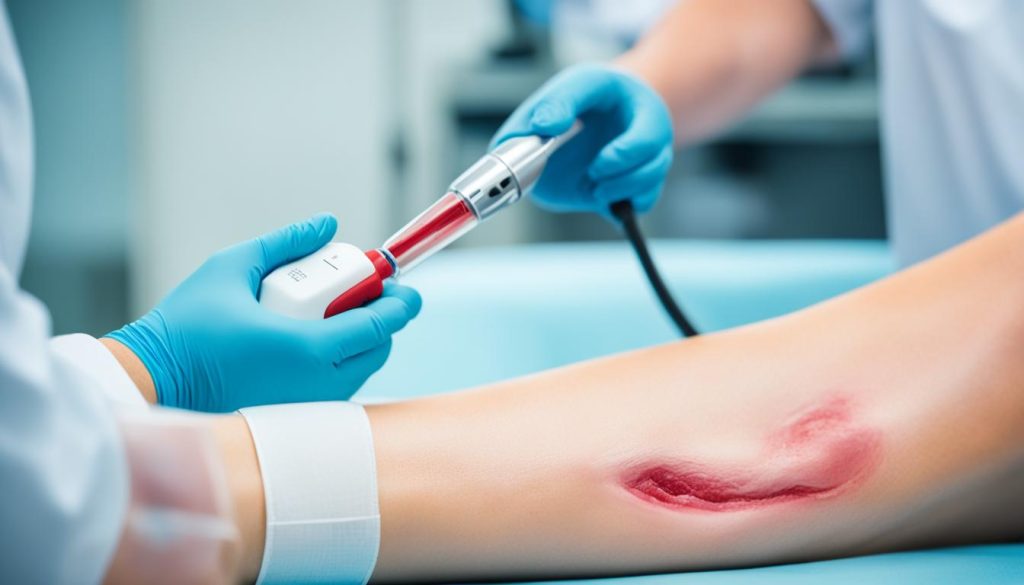Do you know the signs of a blood clot? Understanding the symptoms can be crucial in identifying this potentially serious condition. Blood clots can be life-threatening if not detected and treated promptly.
If you experience throbbing or cramping pain, swelling, redness, or warmth in a leg or arm, these could be signs of a blood clot. Other symptoms to watch out for include sudden breathlessness, sharp chest pain, and coughing up blood.
It’s important not to ignore these symptoms. Seeking medical attention immediately is vital to ensure appropriate diagnosis and treatment. Remember, early detection can make a significant difference in preventing complications.
Stay informed about the signs of a blood clot and take proactive steps to protect your health. Read on to learn more about recognizing blood clots, risk factors, prevention strategies, and when to seek medical attention.
How Do You Know if You Have a Blood Clot?
To ensure your well-being, it is crucial to recognize the signs of a blood clot. By understanding the symptoms and seeking timely medical attention, you can prevent potential complications. Here are some common indicators:
- Swelling, pain, tenderness, and a warm sensation: These are often experienced in the affected area. Pay attention to any unusual changes or discomfort.
- Changes in color and itching: Red or blue discoloration, accompanied by itching, may occur. Monitor your skin for any alterations.
- Symptom variation: The symptoms can vary depending on the location of the clot. It’s important to be aware of the potential differences.
If you suspect a blood clot, it is crucial to undergo proper diagnostic testing. Here are some common blood clot detection methods:
- Ultrasounds: These imaging tests use sound waves to identify blood clots and evaluate blood flow.
- Blood tests: Diagnostic blood tests can detect specific markers indicating the presence of a blood clot in the body.

Recognizing a blood clot and seeking prompt medical attention are vital for your health and well-being. If you experience any of the mentioned symptoms, consult a healthcare professional for a thorough evaluation and proper diagnosis. Early detection plays a crucial role in effective treatment and prevention of complications.
Blood Clot Risk Factors
Certain factors can increase your risk of developing a blood clot. It is important to assess these risk factors and take necessary preventive measures.
Hospitalization or Recent Surgery
- Prolonged bed rest or immobility during hospitalization or recovery from surgery can increase the risk of blood clots.
- Taking proactive steps to stay mobile and active, as advised by your healthcare provider, can help minimize this risk.
Weight and Lifestyle
- Being overweight or obese can contribute to decreased blood flow, making you more susceptible to blood clot formation.
- Maintaining a healthy weight through regular exercise and a balanced diet can help mitigate this risk.
- Smoking, both through direct smoke inhalation and secondhand smoke exposure, can also increase the likelihood of blood clot formation.
- Quitting smoking can significantly reduce your risk and improve overall health.
Hormonal Contraception
- Some forms of hormonal contraception, such as birth control pills or hormone-releasing intrauterine devices (IUDs), can elevate the risk of blood clots.
- If you are considering hormonal contraception, it is important to discuss the potential risks and benefits with your healthcare provider.
Medical History and Conditions
- Prior history of blood clots, whether in the legs (deep vein thrombosis) or lungs (pulmonary embolism), can increase the likelihood of future clotting events.
- Pregnancy and the postpartum period pose a higher risk due to changes in blood composition and reduced mobility.
- Inflammatory conditions such as Crohn’s disease or rheumatoid arthritis can also heighten the risk of blood clots.
- Discussing your medical history and any existing conditions with your healthcare provider can help determine appropriate preventive measures.
By understanding these risk factors and taking necessary precautions, you can reduce your chances of developing a blood clot. It is essential to consult with a healthcare professional for personalized assessments and guidance.

Blood Clot Prevention
Preventing blood clots is crucial for maintaining your overall health and well-being. By taking a few simple steps, you can significantly reduce the risk of blood clot formation. Here are some effective strategies to prevent blood clots:
- Stay Active: Engaging in regular physical activity is essential for promoting proper blood flow throughout your body. Simple exercises like walking, jogging, or cycling can help keep your circulation in check.
- Avoid Prolonged Sitting: Sitting for long periods, especially while traveling or working, can increase the risk of blood clot formation. Take breaks every hour to stretch your legs, move around, and promote healthy blood circulation.
- Maintain a Healthy Weight: Excess weight places additional strain on your cardiovascular system, making you more susceptible to blood clot development. Maintain a healthy weight through a balanced diet and regular exercise.
- Hydrate: Drinking plenty of water throughout the day helps prevent dehydration and promotes optimal blood thickness and circulation. Aim to drink at least 8 cups (64 ounces) of water daily.
- Wear Compression Stockings: Compression stockings apply gentle pressure to your legs, aiding in blood flow and reducing the risk of blood clots. These stockings are especially beneficial during travel or if you have a sedentary lifestyle.
- Avoid Excessive Alcohol Consumption: Alcohol can have a negative impact on blood clotting mechanisms. Limit your alcohol intake to moderate levels to reduce the risk of clot formation.
- Quit Smoking: Smoking damages blood vessels and reduces blood flow, increasing the likelihood of blood clot formation. Quitting smoking is one of the best steps you can take to protect your overall vascular health.
- Take Medication as Prescribed: In some cases, your healthcare provider may prescribe medication to help prevent blood clots. It is essential to take these medications exactly as directed to maximize their effectiveness.
By incorporating these preventive measures into your daily routine, you can significantly lower your risk of blood clots and maintain optimal circulatory health.

When to Seek Medical Attention?
If you suspect you have a blood clot, it is crucial to seek medical attention. Don’t ignore any unusual symptoms, as early detection and treatment are essential to prevent complications. Conditions such as sudden shortness of breath, chest pain, or severe pain in the leg or arm should be evaluated by a healthcare professional immediately.
To properly diagnose a blood clot, doctors utilize various tests and imaging techniques. Whether it’s a physical examination, blood tests, or advanced imaging scans like ultrasounds or CT scans, medical professionals will gather all necessary information to make an accurate diagnosis.
Here are some typical symptoms that may indicate a blood clot:
- Sudden shortness of breath
- Chest pain
- Severe pain in the leg or arm
If you experience any of these symptoms, please reach out to your doctor promptly. Acting quickly can help prevent serious complications associated with blood clots.

| Signs and Symptoms of a Blood Clot | Tests and Imaging Techniques |
|---|---|
| Throbbing or cramping pain | Physical Examination |
| Swelling, redness, and warmth in a leg or arm | Blood Tests |
| Sudden breathlessness | Ultrasounds |
| Sharp chest pain | CT Scans |
| Coughing up blood |
Conclusion
Recognizing the symptoms of a blood clot and understanding the risk factors are crucial steps in taking appropriate actions. If you experience any concerning symptoms or have risk factors, it is important to consult a healthcare professional for proper diagnosis and treatment. Seeking timely medical attention can save lives and prevent serious complications.
Preventive measures play a key role in reducing the risk of blood clots. Staying physically active, maintaining a healthy weight, and adopting a smoke-free lifestyle are effective ways to prevent blood clots. Additionally, avoiding excessive alcohol consumption and staying well-hydrated are important strategies.
Timely diagnosis of blood clots is essential for effective treatment. Medical professionals can utilize various diagnostic techniques such as ultrasounds and blood tests to accurately diagnose blood clots. Treatment options include medication to dissolve the clot or surgery to remove it, depending on the severity of the condition.
Remember, your health should always be a top priority. By being proactive in understanding the symptoms, risk factors, and preventive measures of blood clots, you can take control of your well-being. Consult with your doctor, follow recommended guidelines, and stay informed to minimize the risk of blood clots and promote a healthy lifestyle.
FAQ
1. How can I tell if I have a blood clot?
Symptoms of a blood clot may include throbbing or cramping pain, swelling, redness, and warmth in a leg or arm. Other symptoms can include sudden breathlessness, sharp chest pain, and coughing up blood. It is important to seek medical attention immediately if you experience these symptoms.
2. How can a blood clot be recognized?
Common symptoms of a blood clot can include swelling, pain, tenderness, and a warm sensation in the affected area. Changes in color, such as red or blue discoloration, and itching may also occur. Symptoms can vary depending on the location of the clot.
3. What are the risk factors for developing a blood clot?
Risk factors for blood clot formation include being in the hospital or recently undergoing surgery, being overweight, smoking, using hormonal contraception, having a previous history of blood clots, pregnancy, and inflammatory conditions such as Crohn’s disease or rheumatoid arthritis.
4. How can blood clots be prevented?
To prevent blood clots, it is important to stay active and avoid sitting for long periods of time. Drinking plenty of water, maintaining a healthy weight, wearing compression stockings, and avoiding excessive alcohol consumption and smoking are also recommended preventive measures. In some cases, medication may be prescribed to reduce the risk of clot formation.
5. When should I seek medical attention for a blood clot?
If you experience sudden shortness of breath, chest pain, or severe pain in the leg or arm, it is crucial to seek medical attention. A healthcare professional will be able to diagnose a blood clot through various tests and imaging techniques.




